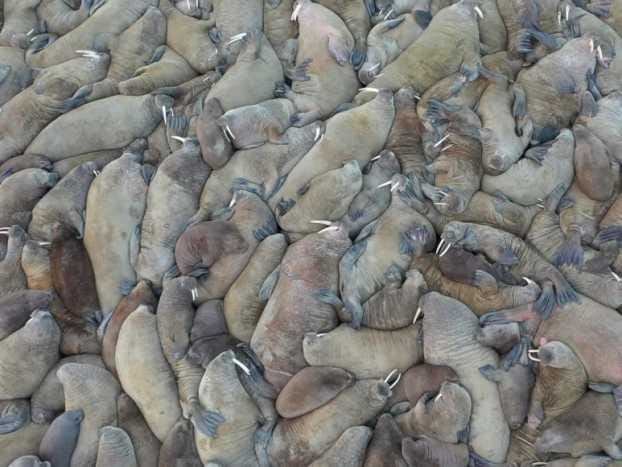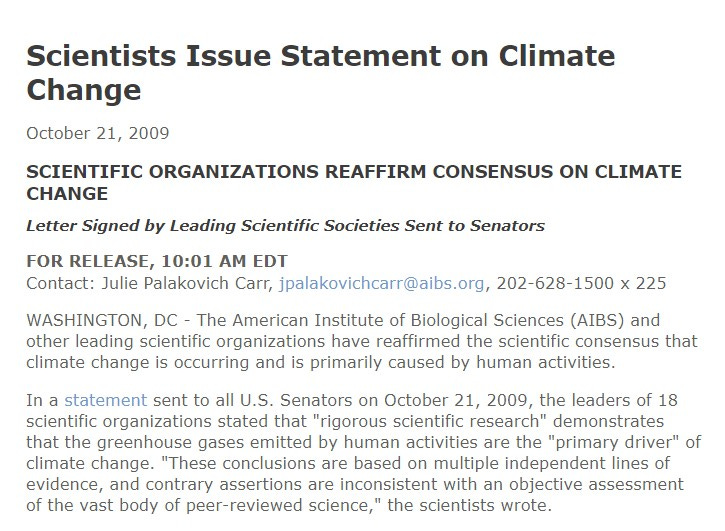Consensus Statements in Science are Disastrous Violations of Principle
A consensus statement on evolution in 2005 was the antithesis of science but led to a similar statement about climate change a few years later
One of the main reasons I turned my attention to polar bear conservation issues in 2008 was because I’d been cut off from doing the evolution research I really wanted to do. How and why that happened — and the story of how it impacted my career — should concern all ethical scientists.
Almost twenty years after I’d started analyzing prehistoric dog bones, I took a dive down an evolutionary rabbit hole as I wondered how – biologically speaking – wolves became dogs.
This resulted in a Ph.D. in Interdisciplinary Studies (Biology/Anthropology) that I’m hugely proud of having earned. It lays out the unique and testable hypothesis that thyroid hormone drives the process of speciation in all multicellular animals — including our human ancestors — with some profound implications for human health. [more details on all this in subsequent posts.]1
However, instead of building a new career around my Magnum Opus, I hit a brick wall.
I went from being invited by scientific journal editors to submit papers on this topic in 2002, to being unable to get a single paper even accepted for review in 2007.2
When I went looking for a reason to explain this shift in attitude, I found that around 2006, all major scientific organizations had published “official” statements on their websites (often in a prominent sidebar) declaring explicitly, in words to the effect that the only acceptable explanation for how evolution works was the accumulation of random mutations in genes over time.
But why on earth did evolutionary biologists make such an unscientific move?
As far as I’ve been able to ascertain, in the early 2000s the evolutionary biology community in the United States was working hard to quash a perceived threat from Creationists. They’d been engaged in a battle with religious factions in some states over the teaching of evolution in high school for more than a decade.
Academic scholars really wanted to stop the Creationist movement in its tracks but the scientific arguments they were using apparently weren’t convincing enough. Leading evolutionary biologists were running out of patience. It seems they decided it was time to wield the power they held as executive board members of prominent scientific organizations.
I didn’t find out until years later that following a conference symposium in 2004 organized by the American Institute of Biological Sciences (AIBS), in 2005 a proceedings volume was published called Evolutionary Science and Society: Educating a New Generation, which included this statement:3
"While teaching evolutionary science, we should increase students' understanding of inquiry and the nature of science and present evolution with a contemporary societal perspective. This book provides science teachers with contemporary essays by leading scientists and appropriate resources by leading educators. All of this should help science teachers educate a new generation." [my emphasis]
In other words, under the guise of providing an up-to-date, “one-stop” volume of free resources for teachers, these “leaders” in their field took the unprecedented step of laying out exactly what was acceptable to teach about evolution and therefore, what could be published in scientific journals. Although perhaps not immediately apparent to outsiders, this was was a book of consensus statements intended for wide distribution.
For example, in the first paper of the section on “How Evolution Works,” senior geneticist Douglas Futuyma made this statement a headline, for maximum emphasis:4
Natural Selection Is a Consistent Difference in the Rate of Increase of Different Genotypes or Genes (and No More Than That) [emphasis in original, pg. 93]
[Note that a similar statement in 1998 was much less specific: “Biological evolution consists of change in the hereditary characteristics of groups of organisms over the course of generations.”]
In another section of the book, botanical geneticist Paul Gepts described plant and animal domestication as “human-made evolution,” stated as fact on page 180.5
I could see immediately that Futuyma’s statement made my paradigm describing a central role for thyroid hormone in driving evolutionary change scientifically unacceptable and explained why I couldn’t get any spin-off papers from my dissertation reviewed by journal editors. In their ignorance of endocrinology and its often-tight association with gene function, I suspect journal editors either saw my thyroid hormone hypothesis as another “Intelligent Design” scheme, or feared it would be used by Creationists to block the teaching of evolution, either of which would raise the ire of their colleagues.
Gepts’ “human-made evolution” statement about domestication also explained why one of my short summary papers submitted to BioScience (the official journal of the AIBS), was rejected outright by editor Timothy Beardsley in 2007 with an outrageous comment regarding my scientific conclusion that it’s a myth that domestic animals were the result of humans deliberately taming wild animals.
He actually stated, “You can’t say that.”
How is this an acceptable statement from a science editor — or even from one scientist to another?
My appeals to reason and evidence fell on deaf ears with the BioScience editor. It was my first experience butting heads with an official demand for a consensus narrative on a topic under active scientific investigation.
I had no idea how to fight it. Demanding consensus wasn’t how science was done – not as I’d been taught. In fact, it’s the very antithesis of science because it halts the innovation and self-correction essential to progress.
I soon abandoned my extremely promising dissertation research because I lost patience with being stonewalled. The only exception was a follow-up investigation I did a few years later on the evolutionary role of iodine in cell-to-cell signalling that I was able to slip through the cracks. It came about as part of a special conference session organized by a developmental biologist for an organization that guaranteed publication of conference papers providing it passed peer review.6
And that’s how I found myself, over the next two decades or so – while making a living identifying animal bones – creating a professional hobby out of challenging polar bear extinction theory and its associated ideological biases in scientific reporting.
But my passionate pursuit of polar bear ecology issues eventually led me back to exactly the same place: butting heads with a consensus statement. This time, the conflict got me cancelled outright by academia because it had become forbidden to challenge leading experts about climate change.
However, for years, I’d wondered exactly when the consensus statement on climate change had become mainstream: had it happened before the evolution incident or afterwards?
I did some Google diving and the Wayback Machine revealed it was indeed the evolution narratives that came first, with the 2005 book of consensus statements.
The climate change consensus was issued in 2009, by the very same biological sciences organization.
The AIBS, apparently emboldened by their success in demanding a consensus narrative on evolution, issued a press release that stated:
“…climate change is occurring and is primarily caused by human activities.” AIBS press release, October 21, 2009. Screencap below, Pdf here.
In other words, the executive board members of these scientific organizations, starting with the AIBS, learned they could define the narrative surrounding evolution to suit their purposes, and then did the same thing for climate change.
In both cases, they did so explicitly to limit the ability of the public and their fellow scientists to challenge their particular interpretation of facts. Censorship was the goal.
It seemingly never occurred to them that they were also standing in the way of scientific advancement — that science could not proceed as it’s supposed to do without the ability of scientists to challenge prevailing paradigms. I expect these science organization board members never considered that they didn’t know everything there was to know about evolution or climate, given that they were the “finest minds” in their field and all.
However, in the case of evolution, these experts have all been conveniently ignoring a well-known weak spot in evolutionary theory called “The Species Problem,” a topic I’ll address in my next post. Unfortunately, their ill-conceived consensus statement on how evolution works never really shut down religious objections to teaching evolution, so it never actually achieved its primary goal — but even worse, it also stopped speciation research from moving forward.
Crockford, S.J. (2004). Animal Domestication and Vertebrate Speciation: A Paradigm for the Origin of Species. Ph.D. dissertation, University of Victoria, filed at the National Library of Canada under "Zoology." http://hdl.handle.net/1828/542
Crockford, S.J. (2006). Rhythms of Life: Thyroid Hormone and the Origin of Species. Trafford, Victoria. [Out of print]
Crockford, S.J. (2002a). Animal domestication and heterochronic speciation: the role of thyroid hormone. In Human Evolution Through Developmental Change, Minugh-Purvis, N. and McNamara, K. (eds.), p.122–153. Johns Hopkins University Press, Baltimore.
Crockford, S.J. (2002b). Thyroid hormones in Neanderthal evolution: A natural or a pathological role? Geographical Review 92, 73–88. https://doi.org/10.1111/j.1931-0846.2002.tb00135.x
Crockford, S.J. (2003). Thyroid hormone rhythms and hominid evolution: A new paradigm implicates pulsatile thyroid hormone secretion in speciation and adaptation changes. International Journal of Comparative Biochemistry and Physiology Part A 135, 105–129. https://doi.org/10.1016/S1095-6433(02)00259-3
Cracraft, J. and Bybee, R.W. (Eds.). (2005). Evolutionary Science and Society: Educating a New Generation. Biological Sciences Curriculum Study (BSCS) and the American Institute of Biological Sciences (AIBS). Colorado Springs, CO. Pdf of entire book here. https://web.archive.org/web/20071111125555/https://bscs.org/curriculumdevelopment/highschool/evolution/pdf.html
Futuyma, D.F. (2005). The nature of natural selection. Evolutionary Science and Society: Educating a New Generation. Cracraft, J. and Bybee, R.W. (eds.), Biological Sciences Curriculum Study (BSCS) and the American Institute of Biological Sciences (AIBS). Colorado Springs, CO, pg. 93-106. Pdf of entire book here. https://web.archive.org/web/20071111125555/https://bscs.org/curriculumdevelopment/highschool/evolution/pdf.html
Gepts, P. (2005). Plant and animal domestication as human-made evolution. Evolutionary Science and Society: Educating a New Generation. Cracraft, J. and Bybee, R.W. (eds.), Biological Sciences Curriculum Study. Colorado Springs, CO, pg. 180-186. Pdf of book here. https://web.archive.org/web/20071111125555/https://bscs.org/curriculumdevelopment/highschool/evolution/pdf.html
Crockford, S.J. 2009. Evolutionary roots of iodine and thyroid hormones in cell-cell signaling. Integrative and Comparative Biology 49:155-166. https://doi.org/10.1093/icb/icp053



